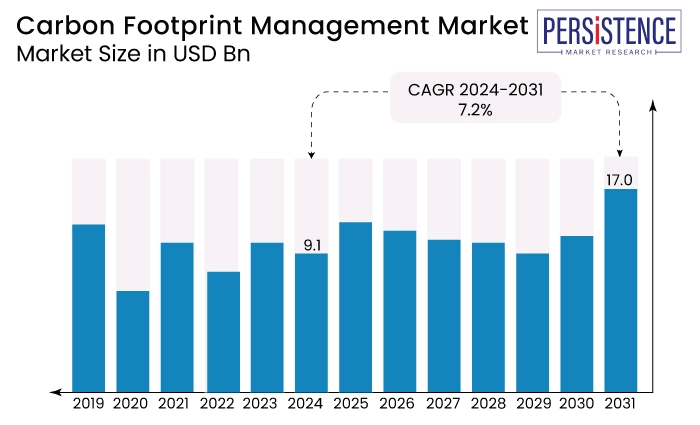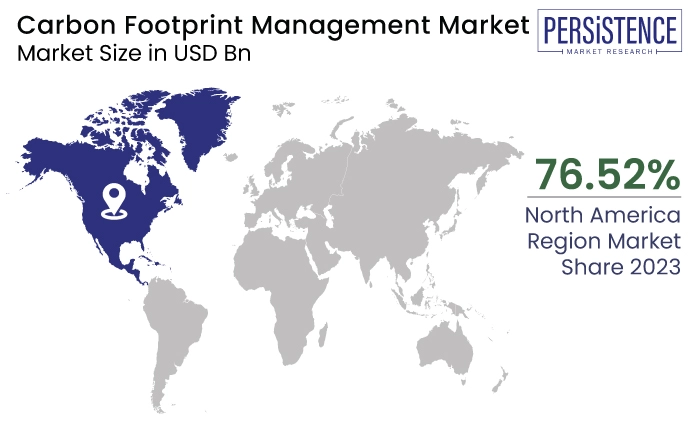ID: PMRREP34288| 169 Pages | 10 Jul 2024 | Format: PDF, Excel, PPT* | Energy & Utilities

The global market is expected to rise from US$9.1 Bn in 2024 to US$17.0 Bn by the end of 2031. The market is anticipated to secure a CAGR of 7.2% during the forecast period from 2024 to 2031.
Key Highlights of the Market Report
|
Attributes |
Key Insights |
|
Carbon Footprint Management Market Size (2024E) |
US$9.1 Bn |
|
Projected Market Value (2031F) |
US$17.0 Bn |
|
Global Market Growth Rate (CAGR 2024 to 2031) |
7.2% |
|
Historical Market Growth Rate (CAGR 2019 to 2023) |
4.1% |
Increasing demand for Carbon Footprint Management Market platforms from different industries which need carbon footprint management software is a key driver for market growth. The integration of latest technology with management platforms which enable real-time tracing and solution-based results. Consequently, prevents the greenhouse gases from reaching the ozone layer.
There is increasing focus on following carbon footprint management tools and software by companies to comply with carbon emissions. This has expanded the demand for carbon footprint management software across industries.
The increasing government initiatives worldwide are estimated to fuel the growth of market. For example,
Increasing climatic issues encourage industries to make aware their employees about the critical condition by educating them. For example,

The market went through notable growth fueled by corporate sustainability initiatives, growing consciousness about climate change and regulatory pressures.
There are several companies adopted sustainability goals such as carbon neutrality pledges that require robust carbon footprint management strategies.
Advances in AI, data analytics and IoT have enhanced the capabilities of carbon footprint management solutions making them effective. The carbon footprint management market exhibited a CAGR of 4.1% during the historical period from 2019 to 2023.
There are many businesses in the world who are likely to set ambitious carbon reduction targets and adopt best carbon management strategies to meet these goals.
Governments are also likely to reinforce regulations aimed at reducing greenhouse gas emissions that will drive adoption of carbon footprint management solutions.
The market for carbon footprint management is projected to record a CAGR of 7.2% during the forecast period from 2024 to 2031.
Sustainable Industrial Practices
Shift to paperless economy and cloud computing provides industries to go for paperless transactions. This recent market trend is fueling the carbon footprint management software sales, which tracks the carbon emission graph too.
The respective governments in evolving countries including India, China and the Middle east are also providing numerous subsidies for industries employing such methods to prevent the greenhouse gas release.
It thus allows governments for taking action to use carbon footprint management software as well as other programs. A few of these steps involve employing filtration caps and tools in industries and factories to reduce carbon emissions.
Growing Energy Consumption by Industries
There is increase in the energy demand of the industrial sector. The commercial sector of the US was responsible for consuming more than 36% of its total energy consumption for 2020 as per an article published by the US Energy Information Administration. Out of this, the manufacturing businesses utilized more than 77% of the energy.
The total production of energy of the United States between 2020 and 2021was 22% as per the US Energy Information Administration. These factors allow industries and governments to use carbon footprint management solutions.
High Implementation Costs, and Growing Complexity
One of the key factors impeding the carbon footprint management market is the high implementation costs and complexity associated with deploying comprehensive carbon footprint management solutions.
Many businesses, particularly small and medium-sized enterprises (SMEs), find it challenging to afford the initial investment required for sophisticated carbon tracking technologies and software.
The complexity of integrating these solutions into existing operational frameworks further deters adoption, as companies fear disruptions to their workflow and productivity. The high implementation costs and complexity of carbon footprint management solutions pose significant barriers to market growth.
For many businesses, especially SMEs, the initial investment required for advanced carbon tracking technologies and software is prohibitive. Moreover, the complexity of integrating these solutions into existing operational processes presents additional challenges, as companies are wary of potential disruptions and productivity losses.
Consequently, despite recognizing the importance of reducing carbon emissions, many organizations hesitate to embrace comprehensive carbon footprint management strategies.
Lack of Stringent Standardization
Despite growing awareness about carbon emissions, the absence of globally uniform regulations and standards hinders the market for carbon footprint management progress.
Inconsistent policies across regions lead to uncertainty for businesses, discouraging them from investing in comprehensive carbon footprint management solutions.
Without clear guidelines, companies may prioritize short-term profits over sustainability initiatives, further impeding market growth. The lack of stringent regulations and standards poses a significant challenge to the market.
Varying policies across different regions create uncertainty, making it difficult for businesses to justify investments in carbon footprint management solutions.
Companies may prioritize immediate financial gains over long-term sustainability efforts in the absence of clear guidelines. This ambiguity not only slows down market growth but also undermines the urgency of addressing carbon emissions on a global scale.
Without cohesive regulatory frameworks, the market struggles to reach its full potential in driving meaningful environmental change.
Increasing Adoption of Advanced Technologies
Increasing adoption of advanced technologies including big data, artificial intelligence and IoT across industries to reduce carbon emission is anticipated to provide key opportunities for the market players. These technologies assist industries to measure their carbon footprint around different operations as well as activities.
Advanced analytics tools also enable for predictive carbon emissions modelling, assisting organization anticipate future emissions scenarios on the basis of various operational decisions. Such proactive approach allows for well planning and mitigation strategies.
Blockchain technology is employed for enhancing transparency in supply chains. Such transparency helps organization track the carbon footprint of their whole supply chain, including logistics partners and supplies.
The Cloud Segment to Hold a Significant Market Share
|
Category |
Market Share in 2023 |
|
Cloud Segment |
54.80% |
The cloud segment is projected to be the largest segment and held 54.80% market share in 2023.
With the growing adoption of cloud based software trending around industries, the demand for cloud based carbon footprint management solutions is increasing significantly. Growth in demand is attributed.
By deployment mode, the cloud segment is estimated to be the largest in the carbon footprint management market during the forecast period. The deployment of a carbon footprint management software over cloud is cost-effective, highly scalable and provides easier execution, maintenance, and upgradation.
Moreover, it offers benefits like security, control over data, speed, and all-time support making it the primary choice of customers.
North America Remains the Dominant Regional Market
|
Country |
Market Share in 2023 |
|
US |
76.52% |
North America market is projected to expand at a significant rate during the forthcoming years. This regional market is the largest market for CCS around globe. This region mainly led by US which accounted for more than 76.52% share in the region in 2023.
The united states in North America stands out as the largest market exhibiting a significant CAGR in the forthcoming years. This significant growth mainly because of the increasing concerns about climate change and the proactive stand of the United States as a worldwide leader to address environmental challenges.
The country's substantial investment in research and development initiatives aimed at devising effective solutions further propels market expansion.
As per an article published by the American environmental non-profit organization, Center for Climate and Energy Solutions, in 2021, 35 carbon tax programs have already been implemented across the region.
Moreover, various countries in this region are implementing serious tax laws and regulations on their businesses and industrial areas to check their carbon footprint.
National governments and international organizations have agreed to limit the global temperature increase to two degrees Celsius. As per the Carbon Dioxide Information Analysis Center (CDIAC), around 91% of current fossil fuels and CO2 emissions are from the US.
The adoption of advanced technologies enabling remote tracking of greenhouse gas (GHG) emissions and carbon footprint adds momentum to market growth in North America. This integration of new-gen technology enhances the efficiency and accuracy of carbon footprint management, thereby driving demand among end-users.
The emissions from North America have reduced from 46.4% in 1950 to 20.5% in 2008. Per capita, the regional excretion of North America has been consistently high and above those of any other region.

In the competitive landscape of Carbon Footprint Management Market, market players deploy various strategies to differentiate themselves. These companies' key competitive advantages lie in their technological innovation, industry experience, and commitment to sustainability, positioning them as leaders in the evolving landscape of carbon footprint management.
Industry participants are focusing mainly on innovation and technological developments to keep the track of CO emissions from different industries. Moreover, these players are implementing strategic initiatives to expand their product portfolio in the market in the forthcoming years.
June 2024
China plans to launch a carbon footprint management system by 2027 to track and reduce emissions across industries, aiming for carbon neutrality by 2060. This system will include standards for calculating carbon footprints for 100 major products by 2027 and expand to 200 by 2030. The initiative emphasizes data accuracy and transparency to support sustainability goals.
March 2024
Matsumoto Precision Inc. has adopted SAP Sustainability Footprint Management to track and report CO2 emissions per product. Partnering with Accenture, the company aims to enhance environmental and economic value through this system. This move supports Matsumoto's vision of a sustainable factory, contributing to greater transparency and reduced carbon footprints in manufacturing.
In 2021
Mastercard has introduced a new Carbon Calculator tool, developed with Swedish fintech Doconomy, to help consumers track the carbon emissions of their purchases. Available globally, this tool offers insights into the environmental impact of spending and encourages sustainable practices. It allows users to contribute to reforestation projects through the Priceless Planet Coalition.
Growing demand for energy consumption by industries is a key factor for market growth.
Some of the leading players in this industry include
Growing intervention of technologies like IoT, Blockchain, and data analytics marks a lucrative opportunity in this market.
North America represents the leading regional market.
Cloud deployment is likely to remain the most sought-after mode.
|
Attributes |
Details |
|
Forecast Period |
2024 to 2031 |
|
Historical Data Available for |
2019 to 2023 |
|
Market Analysis |
US$ Billion for Value |
|
Key Regions Covered |
|
|
Key Countries Covered |
|
|
Key Market Segments Covered |
|
|
Key Companies Profiled |
|
|
Report Coverage |
|
|
Customization & Pricing |
Available upon request |
By Deployment Type
By Component
By End User
By Region
Delivery Timelines
For more information on this report and its delivery timelines please get in touch with our sales team.
About Author